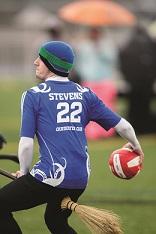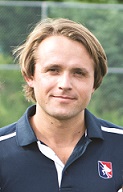

Quidditch 101
The game itself, for those who don’t know, includes a dynamic and varied group of players. Two teams play one another, and each team is made up of seven players, who must play with brooms between their legs at all times. The Keeper is responsible for guarding the goal. Three Chasers are responsible for trying to put the Quaffle (a volleyball) through the goal to score a point. The two Beaters, meanwhile, use dodge balls called Bludgers to disrupt the flow of the game by “knocking out” other players. The Seeker is solely responsible for catching the Snitch (a neutral player whose uniform includes a long tail attached to the back of the shorts with Velcro). It is the job of the Snitch to evade the Seeker). When the Snitch is caught (the Seeker must pull the tail off the back of the Snitch’s shorts to prove capture), the team with the highest score wins. Obviously, this means the duration of a match varies, but it is generally between 30 and 40 minutes.
When we look at the athletes, we see that people come into the sport from a variety of athletic backgrounds. Seeker and Snitch athletes tend to come from a running or cross-country background. Chasers, because they’re offensive players, tend to have skills from rugby, basketball and water polo; Beaters are often dodgeball players. The Keeper is like a soccer or hockey goalie. It really is a very physical, demanding, active sport and it appeals to people with different skills.

The sport of quidditch began, as mentioned previously in 2005, and was first recorded as being played on college campuses. Our main demographic, therefore, is college students, 18-22 years old, and we currently have over 150 college teams; the number of teams has been increasing each year since we incorporated. However, what we’re seeing now is that as students finish college, they still love the sport and want to keep playing, so they have been organizing recreational teams in their own cities. Those are known as community teams. Because the athletes on those teams are all fairly recent college graduates, they do continue to play against college teams. We anticipate that as the numbers of these post-college teams grow, they’ll start to have their own events, playing other community teams. Our website has a list of all our member teams, as well as information on resources such as start-up grants.
When it comes to data concerning male vs female players, we’re still updating those figures, but at the moment, we have slightly more male players, maybe 53%. That’s data from a random sampling done in 2012 by a third party, using a random sampling of players. Our rules state that teams have to be co-ed, and that each seven-person team can’t have more than four team members of the same gender on the field.
As far as we know, quidditch is the only co-ed tackle sport out there. We do not require helmets but we do emphasize education and safety. It has been our opinion that if we put too much safety equipment on people, they will just hit one another harder. If instructed, they play safer.
The college season begins in August and ends in May. Most matches take place from September to the end of November, and then pick up again from February to the end of April. Community teams, of course, can play year-round.

US Quidditch has the mission of governing, promoting and developing the sport, and inspiring people to lead more active lives. We organize events, offer insurance and provide sanctioning. Our website has a calendar where member teams can list their own events. We offer eight regional championships and one national championship per year. Every two years, we hold a convention called QuidCon.
The locations for those events are chosen through a bid process, and the bidding documents can be found on our website. We work with a third-party consulting company, OAN Sports Marketing, to help us get bids. In general, we prefer to use large soccer complexes for our events. A full-size soccer field can fit two games at once, but we like to use one field.
We typically look for well-maintained fields with lighting because many of our games are held after dark. It is very important to us that facilities are as state-of-the-art as possible and have convenient parking, restrooms, all the sort of high-quality amenities that an athlete looks for. For our largest tournaments, we like to have facilities with built-in seating or the ability to bring in bleachers. Our regional championship brings in between 10 and 30 teams, meaning there are 200-700 players coming into the city where the event is being held. Our national championship, depending on the city, can have 3,000 to 8,000 attendees. Obviously, the economic impact is going to depend on the numbers there, but it can get into the millions. By the way, we use a stay-to-play policy for all teams coming in from at least a 100-mile radius.

There is definitely room for expansion and growth in the sport. In addition to the post-college market, which we know will continue to grow, we anticipate expanding into high schools. We also expect to see a lot of growth internationally as more attention is focused on the sport. It will be interesting to see where this leads.
Evolution of Rules
From something that started in one college, to what we have now, the sport has changed, and the rules have become much more specific. There are obviously rules regarding the size of the field, but also for the height of the goals, the types of balls used and more. There also have been changes to the game itself. Whereas in the beginning, the Snitch was out on the field the whole time, now, the Snitch does not enter the game until the 18th minute. A new rule is that once he or she has entered the game, the Snitch has to stay in the field of play. Previously, the Snitch could run off the field and still could be pursued and caught by the Seeker, which made it confusing for spectators since they couldn’t see that part of the match. Keeping the Snitch in view is better from a safety standpoint and from an officiating standpoint as well. It’s a new probationary rule this year, but it has been very well received by our players and our spectators.
Each match needs a minimum of six referees – ideally, you’d like eight – and those referees are paid. People who want to become a referee for this sport need to pass both a written test and a field test in order to be certified. We are projecting that we will have 75 certified head referees by the end of this season. Each referee has assistants. It’s a demanding job.

A lot of times, people think of quidditch as some kind of a role-playing activity that has to do with the Harry Potter books. It takes actually watching a match and seeing how exciting and athletic the play is for people to understand it is a real sport, and that it takes real skills to participate at a competitive level.
It’s probably fair to say that at this point, most of the people playing quidditch grew up reading the Harry Potter books; they really are the “Star Wars” of the generation. Increasingly, though, we’re seeing the attention moving away from the books and focusing on the athletes and the seriousness of quidditch as a sport. Once you see it, you’ll understand why.

